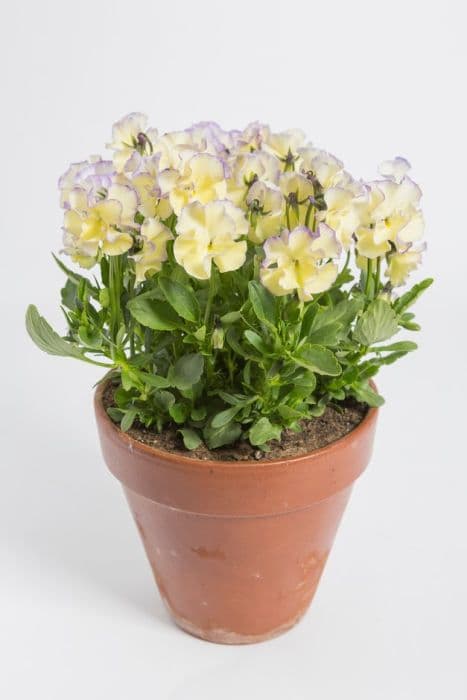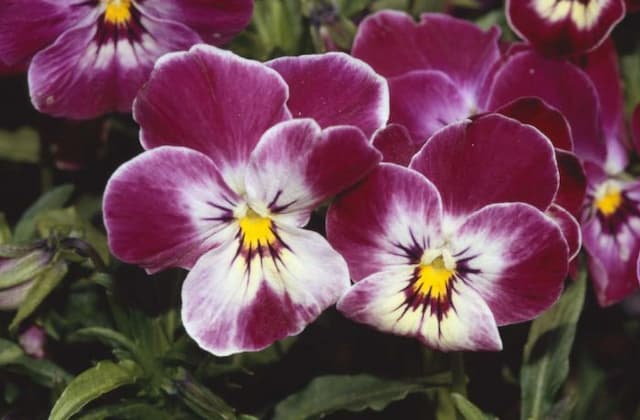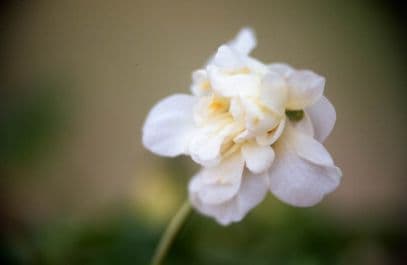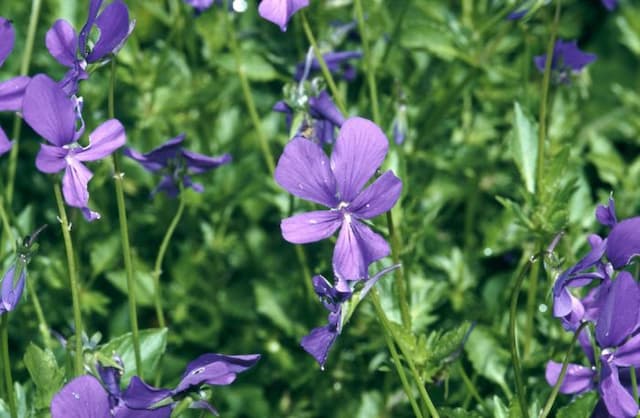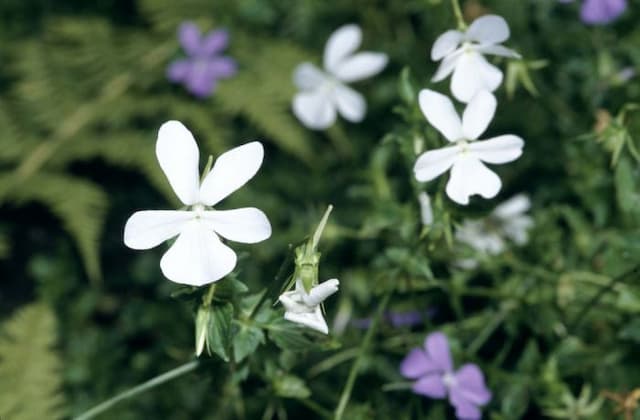Double Purple Violet Viola 'Pallida Plena' (dPVt)

ABOUT
Viola 'Pallida Plena' is a striking perennial plant characterized by its full double flowers. These blossoms come in a delicate lavender to purple shade, showcasing a beautiful gradient of pastel hues. The petals are ruffled and dense, giving the flower a pompom-like appearance, which makes them highly decorative and appealing in garden settings. The foliage of the Viola 'Pallida Plena' forms a lush backdrop to the showy flowers. The leaves are typically heart-shaped or rounded, presenting a bright green color that contrasts nicely with the floral display. This plant tends to form a clumping habit, with the flowers rising just above the greenery to catch the eye of onlookers and attract pollinators. Viola 'Pallida Plena' blooms exquisitely during the cooler months of the year, often enlivening the garden when many other plants have ceased to flower. The overall impression of this plant is one of charming delicacy, with its pastel flowers and neat foliage creating a soft and romantic aesthetic ideal for borders, rockeries, and as underplanting beneath taller plants that provide dappled shade.
About this plant
 Names
NamesFamily
Violaceae
Synonyms
Double Purple Violet, Double Blue Violet
Common names
Viola 'Pallida Plena'
 Toxicity
ToxicityTo humans
The plant commonly known as pansy is generally considered safe and non-toxic to humans. It is not known to cause poisoning if ingested, and there are no commonly reported symptoms of toxicity from consuming parts of this plant.
To pets
Pansies are also generally considered non-toxic to pets. There are no significant toxic effects expected if pets ingest parts of this plant. However, individual animals might have different sensitivities, and consuming plant material can sometimes cause mild gastrointestinal upset regardless of toxicity.
 Characteristics
CharacteristicsLife cycle
Perennials
Foliage type
Evergreen
Color of leaves
Green
Flower color
Blue
Height
0.5 feet (15 centimeters)
Spread
0.5 feet (15 centimeters)
Plant type
Herb
Hardiness zones
4
Native area
Europe
Benefits
 General Benefits
General Benefits- Ornamental Appeal: The Viola 'Pallida Plena', commonly known as double purple violet, boasts attractive double flowers that add aesthetic value to gardens and landscapes.
- Pollinator Attraction: These plants attract bees, butterflies, and other beneficial insects that facilitate pollination of nearby plants.
- Seasonal Interest: Double purple violets have a prolonged flowering period, which extends from early spring through autumn, providing visual interest throughout the growing season.
- Ground Cover: With a compact growth habit, double purple violets can effectively cover bare ground, reducing weed growth and soil erosion.
- Low Maintenance: They are relatively easy to grow and maintain, requiring minimal care once established, making them a convenient choice for gardeners of all skill levels.
- Hardiness: Double purple violets are hardy in a range of climates and can tolerate varying soil conditions, which make them a resilient addition to diverse garden settings.
 Medical Properties
Medical Properties- Anti-inflammatory: Viola plants are traditionally used for their anti-inflammatory properties.
- Expectorant: They can act as expectorants to help clear congestion in the respiratory tracts.
- Antirheumatic: Some Viola species have been utilized to alleviate symptoms of rheumatism.
- Diuretic: They may have diuretic effects that can aid in relieving fluid retention.
- Demulcent: The mucilage content in Viola can soothe and protect irritated or inflamed internal tissues.
- Antibacterial: Certain compounds in Viola exhibit antibacterial activity against various pathogens.
 Air-purifying Qualities
Air-purifying QualitiesThis plant is not specifically known for air purifying qualities.
 Other Uses
Other Uses- Perfumery: The subtle fragrance of the Sweet Violet can be used to create natural perfumes or to provide a gentle scent to lotions and other cosmetic products.
- Floral Arrangements: Sweet Violet flowers can be used in small floral arrangements or boutonnieres to add a touch of elegance and color.
- Eco-friendly Dye: The petals of the Sweet Violet can be used to make a natural dye for textiles, resulting in soft lavender to blue hues.
- Culinary Garnish: The delicate flowers can be used as an attractive edible garnish on desserts and salads, enhancing the presentation with their color.
- Floral Ice Cubes: Freeze Sweet Violet flowers in ice cubes for an ornamental addition to beverages, perfect for spring and summer events.
- Aromatherapy: The relaxing scent of the Sweet Violet can be utilized in aromatherapy to create a serene atmosphere in your home or workspace.
- Homemade Syrup: The flowers can be used to make a Sweet Violet syrup, which can then be added to cocktails or used as a flavoring for desserts.
- Candle Making: The essence of Sweet Violet can be infused into candles, providing a gentle aroma when lit.
- Botanical Art: Dried Sweet Violet flowers can be used in botanical art projects, such as pressed flower crafts or resin jewelry.
- Wedding Confetti: Dried Sweet Violet petals can be used as biodegradable wedding confetti, offering an eco-friendly alternative to paper or plastic.
Interesting Facts
 Feng Shui
Feng ShuiThe Double Purple Violet is not used in Feng Shui practice.
 Zodiac Sign Compitability
Zodiac Sign CompitabilityThe Double Purple Violet is not used in astrology practice.
 Plant Symbolism
Plant Symbolism- Modesty: The Viola, often recognized as a modest flower due to its small and unassuming appearance, represents humility and a quiet charm.
- Innocence: With its delicate petals, the Viola is frequently associated with purity and innocence, reminiscent of a more innocent and carefree time.
- Spiritual Wisdom: In various cultures, these flowers are seen as a symbol of spiritual enlightenment, representing an inner journey or the quest for higher understanding.
- Eternal love: The enduring and persevering qualities of the Viola are often paralleled with faithful and everlasting love.
- Healing: Violas have been used in herbal medicine for centuries, symbolizing healing and therapeutic powers.
 Water
WaterThe common pansy, including the Viola 'Pallida Plena', requires consistent moisture and should be watered thoroughly once the top inch of the soil feels dry to the touch. Water the plant whenever the soil condition meets this dryness criterion, which might occur approximately once a week, depending on environmental factors such as temperature and humidity. When watering, it's important to avoid wetting the foliage, so direct the water to the base of the plant instead. Provide the pansy with about one gallon of water for each watering session to ensure the moisture reaches the root zone. During hot, dry periods, more frequent watering may be necessary to maintain soil moisture.
 Light
LightThe best light conditions for a common pansy like Viola 'Pallida Plena' are in an area that receives partial shade to full sun. An ideal spot would have morning sunlight and some afternoon shade to protect the plant from intense midday heat. Pansies appreciate bright light but not the scorching sun.
 Temperature
TemperatureCommon pansies, including Viola 'Pallida Plena', thrive in cooler temperatures and can generally withstand short periods of frost, typically down to about 25 degrees Fahrenheit. They prefer a temperature range between 40 and 60 degrees Fahrenheit but can survive outside this range for short periods. Pansies perform best in the cooler temperatures of spring and fall.
 Pruning
PruningPruning common pansies like Viola 'Pallida Plena' involves deadheading the spent flowers to encourage more blooms and maintain plant vigor. This should be done regularly throughout the blooming season. The best time for more extensive pruning or cutting back is after the first flush of flowers has faded, which helps to stimulate a second bloom period.
 Cleaning
CleaningAs needed
 Soil
SoilThe best soil mix for the Sweet Violet (Viola 'Pallida Plena') should be rich, moist, and well-draining with high organic content. A mixture of loamy garden soil, peat moss, and perlite or sand is ideal. The soil pH should be slightly acidic to neutral, ranging from 6.0 to 7.0.
 Repotting
RepottingSweet Violets (Viola 'Pallida Plena') should be repotted every 1-2 years to ensure they have enough room to grow and to replenish the soil nutrients. Early spring, just before the growing season, is the best time to repot these plants.
 Humidity & Misting
Humidity & MistingSweet Violets (Viola 'Pallida Plena') thrive best in moderate humidity levels. Aim for humidity around 50%, which is typical for an indoor environment. These plants do not require excessively high humidity and can adapt to average home conditions.
 Suitable locations
Suitable locationsIndoor
Place in bright, indirect light and maintain moist soil for indoor Sweet Violet growth.
Outdoor
Plant in partial shade, ensure moist soil, and protect from extreme heat for outdoor Sweet Violet growth.
Hardiness zone
4-9 USDA
 Life cycle
Life cycleThe common name of Viola 'Pallida Plena' (dPVt) is Double Violet. The life cycle of Double Violet begins with seed germination, typically in spring or autumn, when temperatures are cool and moisture is abundant, allowing the seeds to sprout. Following germination, the seedling stage is characterized by the growth of cotyledons (first leaves) which provide energy for the young plant to develop true leaves and establish a root system. The vegetative stage follows as the plant develops a rosette of leaves and strengthens its root structure, preparing for flowering. Flowering occurs in the Double Violet during the cooler months of spring or sometimes in fall, producing the characteristic full, double-petaled, violet flowers that can be pollinated by insects, leading to the production of seeds. After flowering, the plant may enter a period of dormancy during hot or freezing weather and may die back, only to regrow from its rootstock or self-sown seeds the following year, completing the life cycle.
 Propogation
PropogationPropogation time
Spring-Early Summer
Viola 'Pallida Plena', commonly known as the Double Purple Violet, can be propagated through division, which is the most popular method. This is typically done in the spring or fall when the plant is not in active bloom. The clump of the violet is carefully dug up, and with a sharp knife or spade, it is split into smaller sections, ensuring each new section has a portion of the roots. The divisions are then replanted at the same soil depth they were growing at previously, spaced about 6 to 12 inches (approximately 15 to 30 centimeters) apart to allow for adequate growth. The soil should be kept moist but not waterlogged to encourage root development. This method allows gardeners to quickly and effectively increase the number of plants in their garden while maintaining the genetic consistency of the Viola 'Pallida Plena'.
